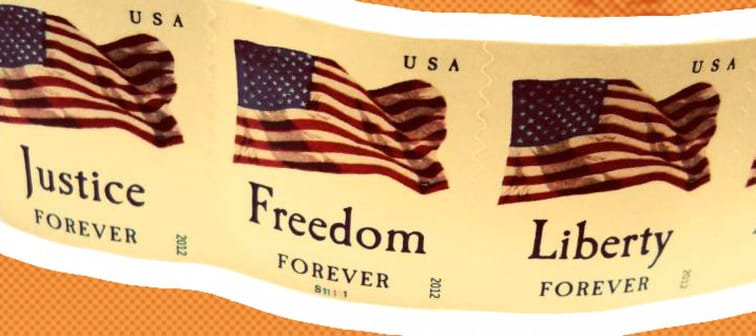When will the cost of a forever stamp increase?
The increase in the cost of the forever stamp is effective July 9, 2023, up to 66 cents from 63 cents, marking the second increase this year. The Postal Service announced back in April that the price for a first-class forever stamp would again be going up to offset the rise in inflation.
The price of the forever stamp increased last on Jan. 22, 2023, up to 63 cents from 60 cents.
The price announcement was part of the USPS' Delivering for America 10-year plan to achieve finanical stability.
The Postal Service started 2022 by making no change in the price of a forever stamp or the first-class letter rate, but hiked prices on July 10, 2022.
Officials noted around the time of last year's increase that the Postal Service is losing billions of dollars because of a 28% drop in mail volume over the last 10 years.
Meanwhile, 2022 brought an average 3.1% increase in rates for Priority Mail services.
To give a couple of examples: The cost of using a Priority Mail medium flat-rate box climbed to $16.10 from $15.50, and the rate for a small flat-rate box went up to $9.45 from $8.45.
Postal officials say they believe these new rates will help keep the Postal Service competitive while providing some needed revenue.
Kiss Your Credit Card Debt Goodbye
Having a single loan to pay off makes it easier to manage your payments, and you can often get a better interest rate than what you might be paying on credit cards and car loans.
Fiona is an online marketplace offering personalized loan options based on your unique financial situation.
When you consolidate your debt with a personal loan, you can roll your payments into one monthly installment. Find a lower interest rate and pay down your debt faster today.
Get StartedHow do forever stamps work?
Forever stamps were introduced by the Postal Service in 2007 and are intended for use on regular, or first-class, letters. The very first forever stamp featured the image of the Liberty Bell.
Since 2011, all 1-ounce first-class stamps have been forevers.
Regardless of how much you pay for a forever stamp, you can use one to send a regular letter (no heavier than an ounce) forever. So if a stamp was worth 49 cents when you bought it and the price of mailing a letter has since gone up to 60 cents, you can still use that old stamp.
Forever stamps are sold in sheets, rolls and booklets of 20. You can buy them in person at your local post office or from the USPS over the phone or online. Some grocery stores and chain drugstores also sell forever stamps.
How many forever stamps do I need?
Within the U.S., you need only a single forever stamp to send a regular-sized letter. The stamps are always sold at the same price as regular first-class postage.
But if you’re sending an oversized letter or mailing something internationally, you can use a forever stamp, but you’ll need to attach additional postage. Your forever stamp will be worth the domestic first-class-mail letter price the day you use it.
You might use two or more forever stamps on letters that are weightier or are going to international destinations, but that may not be the best strategy.
Postage for an additional ounce costs 24 cents. So if you've got a letter weighing in at close to 2 ounces and you add a second forever stamp worth 60 cents, you’ll be paying $1.20, not the required 84 cents. That's paying 36 cents too much.
It's better to save your forever stamps for regular mail and buy a mix of stamps in smaller and larger denominations to help you hit the higher rates on oversized and international letters and cards.
Stop overpaying for home insurance
Home insurance is an essential expense – one that can often be pricey. You can lower your monthly recurring expenses by finding a more economical alternative for home insurance.
SmartFinancial can help you do just that. SmartFinancial’s online marketplace of vetted home insurance providers allows you to quickly shop around for rates from the country’s top insurance companies, and ensure you’re paying the lowest price possible for your home insurance.
Explore better ratesWhy do we have forever stamps?
Postage prices are roughly tied to inflation. The U.S. Postal Service requests rate increases as inflation rises, meaning prices at the post office go up most years.
A good deal of the USPS' revenue comes from stamps — so why does it want you using older forever stamps when rates go up? Wouldn't it make more sense for the agency to make and sell new stamps with higher values?
Well, it turns out that the increased revenue from offering new, costlier stamps would be more than offset by the expense of having to collect and destroy outdated stamps each time the postage rate changes.
With forever stamps, everyone wins. You can buy a stockpile of stamps when rates are set to go up and save yourself those extra cents.
Meanwhile, the Postal Service wins because it will never have to track down "expired" postage.
Sponsored
Follow These Steps if you Want to Retire Early
Secure your financial future with a tailored plan to maximize investments, navigate taxes, and retire comfortably.
Zoe Financial is an online platform that can match you with a network of vetted fiduciary advisors who are evaluated based on their credentials, education, experience, and pricing. The best part? - there is no fee to find an advisor.







